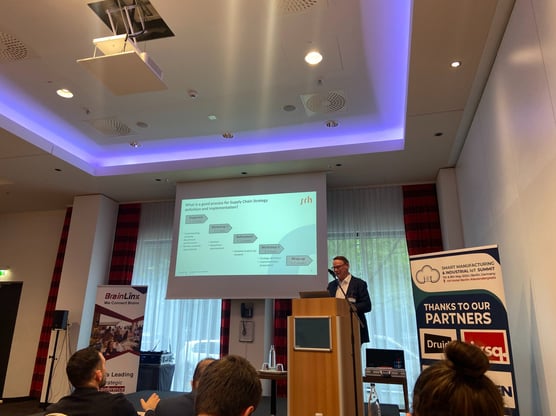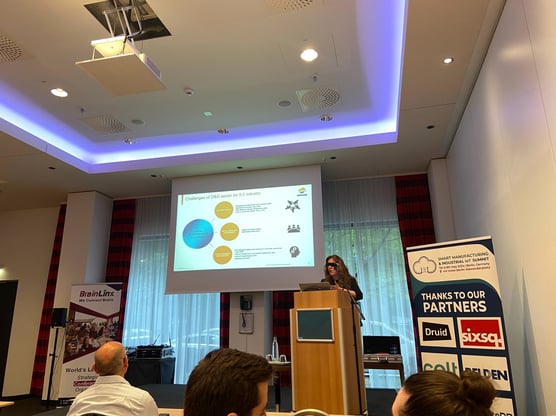In today's age of rapid digital transformation, the manufacturing industry is increasingly leveraging IoT technologies to improve efficiency and productivity. However, this shift has challenges, particularly from an IT perspective.
Experts with diverse backgrounds gathered at the Smart Manufacturing & IoT Summit in Berlin to discuss the industry's challenges and share solutions from their digital transformation experiences in both the research field and business.
Navigating IoT challenges
Korbinian Lehner, a Senior Client Executive at Dell Technologies, provided his valuable insights and experiences regarding the IT complexities and challenges encountered in factories.
IoT Challenges in Data Management
According to Korbinian Lehner, managing data in IoT involves various aspects, from connectivity and data collection to collecting, processing, storing, and implementing a data lakehouse:
- Connect: Building the Right Infrastructure. To start any IIoT initiative, having a reliable infrastructure is crucial. This involves establishing IIoT application platforms and a robust Industrial Edge Infrastructure (IaaS) to manage IIoT devices effectively.
- Collect: Seamless Data Ingestion. Collecting data efficiently is the next step. Smart gateways enable the streaming of data, ensuring that information flows smoothly from devices to the processing units.
- Process: Leveraging Edge Compute. Processing data at the edge involves several critical tasks. This includes selecting relevant data, handling GPU and machine learning workloads, utilizing AI analytics and dashboards, and using IaaS and PaaS technologies (e.g., HyperVisor, containerized applications).
- Store: Reliable Storage Solutions. Storing data effectively is important for quick access and recovery. Solutions such as Network-Attached Storage (NAS), Virtual Storage Area Networks (VSAN), and responsive disaster recovery systems ensure data integrity and availability.
- Data Lakehouse: Ensuring Seamless Connectivity and Security. It is essential to ensure seamless hybrid-/multi-cloud connectivity, robust cybersecurity, and efficient access and identity management.
Shopfloor and Edge IT Challenges
Factories today face various challenges, including a heterogeneous brownfield environment across factories, a low degree of standardization, automation, remote management, and a limited number of skilled IT resources. Large plants may have over 40,000 IIoT devices.
In addition, Edge IT & data management requirements include storing and computing a massive amount of IIoT device data close to its source, creating a Data Lakehouse with defined data subsets/norms for different layers of the MES pyramid, ensuring secure multi-cloud connectivity with identity management, and defining Artificial Intelligence IoT Use Cases (e.g., OM with video analytics/streaming data).
Leveraging digital solutions for smart manufacturing
To overcome these challenges, Prof. Dr. Torsten Becker, the Head of the Supply Chain Management Study Program at SRH Berlin University of Applied Sciences, outlines how digital solutions can provide distinct operational advantages. These benefits effectively solve the challenges faced in smart manufacturing.
 Prof. Dr. Torsten Becker, the Head of the Supply Chain Management Study Program at SRH Berlin University of Applied Sciences
Prof. Dr. Torsten Becker, the Head of the Supply Chain Management Study Program at SRH Berlin University of Applied Sciences
Data Capture
Data capture can be improved by capturing additional data with sensors, acquiring data faster and more frequently, and using location-based data. The benefits include updated and specific data instead of large, unorganized data sets.
Computation
More extensive and special case calculations can provide better information faster, improving the decision-making process.
Communication
Sharing information with all stakeholders, using information in automated form, and accelerating interfaces can lead to integrated partners, integrated processing, and total information availability.
Analytics
Condensing data into information, reusing data, identifying trends and patterns, and developing predictions can improve the information base for decision-making.
Intelligence
Using patterns, machine learning, rule-based learning, and generative AI can lead to faster actions and responsive systems.
The Digital Roadmap
Finally, Tamara Garcia Bermejo, E&P Digital Lead at Repsol, shared her insights on how digital roadmaps facilitate the increase of business process maturity and digital complexity. A digital roadmap focuses on data collection and visualization, monitoring and diagnosis, analytics, simulation and prediction, and automatization. The first two stages help accelerate response, while the next three stages contribute to business parameter optimization.
 Tamara Garcia Bermejo, E&P Digital Lead at Repsol
Tamara Garcia Bermejo, E&P Digital Lead at Repsol
CrateDB for changing your Smart Manufacturing landscape
CrateDB, the Enterprise database for time series, documents, and vectors, plays a pivotal role in digital transformation within smart manufacturing. CrateDB offers immediate insights into diverse data types, which enables real-time analytics, scalable data storage, and predictive maintenance capabilities, leading to improved user experiences, optimized operations, and efficient IoT data management.
Embracing digitalization in the manufacturing industry is key to solving the evolving data demands and challenges. Strategic planning, implementation, and the right approach to IoT data management are essential components to navigate this digital transformation journey successfully.

